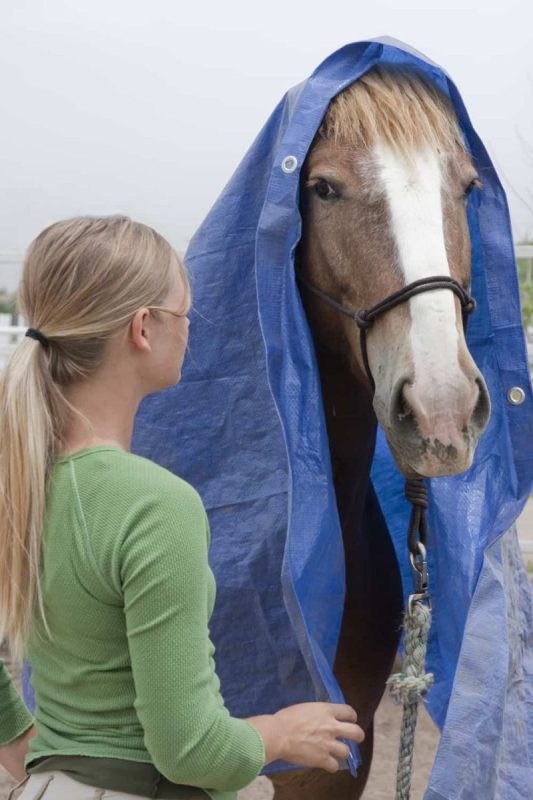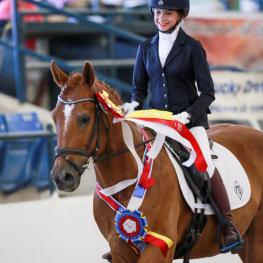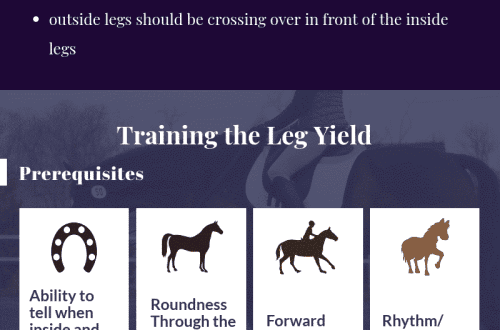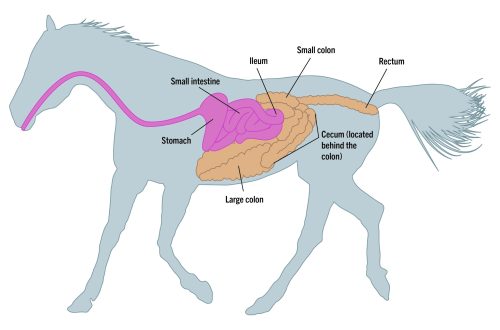
Desensitization: Give Your Horse Confidence
Desensitization: Give Your Horse Confidence
Fright is a natural reaction of horses. They are prey animals with a highly developed flight instinct, which means that they would rather run away from danger than fight it. Boost your horse’s confidence by doing some light desensitizing exercises with him.
Rope
Start with the least scary object you have, the lead.
Stand next to the horse at a 45-degree angle to his shoulder, slightly away, at arm’s length from his head, so that the horse will not hit you if he is scared. When doing the exercise on the left side, hold the lead in your left hand, about 30 cm from the carabiner, so that the horse can move, but remain under your control. This hand also blocks attempts to push you if the horse gets scared.
After you get into place, with your right hand, throw the rest of the lead on the withers of the horse. Rhythmically throw it and pull it from the back. Keep throwing the rope even if the horse gets nervous and walks away – just throw the rope and walk beside the horse. If the horse tries to run away, turn his head towards you – let him look at you and focus on your actions. If the horse stops, you stop too. Give a signal (like a clicker) and give your horse a treat to reward him for relaxing and showing him that he is on the right track. If the horse stays still but raises its head, wait until it relaxes, lowers its head, blinks, snorts calmly, or eases its hind leg to rest. Stop throwing the rope as soon as the horse shows signs of relaxation. At the same time give her a signal, treat her and let her stand quietly. When the horse is comfortable with the presence of the rope at the withers, start throwing it on the back, croup, front legs, and then (gently) on the neck and head. Repeat the exercise on both sides. Once the horse is used to the rope, move on to desensitize the horse to a carrot stick or whip.
Carrot stick or whip
Stand in the same position as when working with the rope, but instead of holding the rope in two hands, hold it with only one hand closest to the horse. Let the end of the rope descend to the ground. This time, drop the cord that attaches to the end of the carrot stick or whip, just like you did with the rope. As you pull the cord off the horse, hit it on the ground to make it click. At the same time, when throwing it at the horse, be gentle and try not to hit it. You must do this rhythmically, without long pauses. If you stop every time you pull the cord, the horse will be rewarded with a rest, even if he didn’t deserve it. When he shows signs of relaxation, stop throwing the line, give the signal (clicker), treat the horse and let it stand. Then start again until the horse begins to feel relaxed about your manipulation of the whip or stick all over his body. Again, starting at the withers, then moving on to the back, croup, hind legs, neck and head.
whip clicks
Click on the ground with a whip. This sound disturbs many horses and they tend to run away from such “pressure”. This lesson will be especially useful for horses that tend to be frightened by various sounds.
Stand parallel to the horse’s jaw at arm’s length, as you did during the first two lessons. Hold the whip by moving it to the side. Start by gently hitting the ground. If the horse gets scared, keep hitting the ground with the same intensity and the same distance from the horse until he stops and relaxes as in the previous lesson. Slowly move the hand with the whip closer to the horse until you are hitting very close to it. If the horse gets restless and walks, continue to accompany him by hitting the whip until he stops and relaxes, then signal (clicker), treat and start again. After the horse is comfortable with tapping on the ground at withers level, move on and tap at the body, at the hind legs, until you can tap directly behind the horse. Start with low pressure and gradually increase the amount to medium until the horse gets used to it. Move on until you can flick the ground on either side of the horse.
In the same way, you can train your horse to touch the whip/stick anywhere on his body. Complicate the exercise gradually. If the horse gets scared or tries to leave, keep the pressure on, make him look at you, but don’t let him push and run over you. If she tries to knock you down, send a wave down the rope as aggressively as you need to drive her out of your space while still tapping the horse with the whip/wand. Stop tapping when the horse relaxes, give a signal (clicker) and a treat.
Plastic bag
By accustoming a horse to packages, you will add confidence not only to the horse, but also to yourself, because everyone knows that the package is one of the most famous and “dangerous” horse-eaters, a meeting with which on a forest path can give you a few unpleasant seconds. Your lessons will teach the horse that the bags are safe.
Start with a small plastic bag and work your way up to trash bags and tarps. All you will need for the first lesson is a whip/carrot stick and a plastic bag. Attach a bag to the tip of the whip. Cut off the bottom of it so that air can pass through (this will make it easier for you to move the bag through the air).
Stand at a 45 degree angle to the horse’s front leg, holding the lead in the hand closest to the horse, 30 cm from the carabiner. In your outer hand, hold a whip with a bag on the end. Take your hand to the side and start tapping the whip on the ground, moving it up and down. At first, do it gently and smoothly. When the horse shows signs of relaxation, give a signal (clicker), stop shaking the bag, treat the horse.
Gradually, tapping, move the stick with the bag closer to the horse. Move the bag closer to the horse only when he is relaxed and standing still. If the horse gets agitated and begins to move its legs, tap without moving. Wait until the horse stops, then immediately stop shaking the bag, give the signal (clicker) and treat. Let the horse stand for a minute, then start from the very beginning, again tapping away from the horse and gradually bringing the bag closer to him. If the horse is not moving its legs but is instead raising its head and tensing its body, keep moving the pack up and down in the same spot (where you tapped when the horse got excited) until it lowers its head, blinks, or eases. back leg. Give the signal (clicker) and stop shaking the bag as soon as the horse relaxes, then treat him. Repeat the exercise on the other side of the horse. When you can shake the bag on the whip up and down close to the horse on both sides, and he remains relaxed, move on to preparing for touching the bag.
Start shaking the whip in the air slowly and rhythmically at a distance of 60-90 cm from the horse. You should always shake the bag in the air first before touching the horse. If the horse is standing still and/or relaxed, head down, blinking or easing his hind leg, stop shaking the bag, give the signal, give the horse a treat and let it stand for a minute.
When the horse begins to calmly respond to the touch of the bag on the withers, move back along the back to the croup, down the hind legs, over the front legs, ending with the neck and head. If the horse is excited, keep shaking the bag with the same energy and in the same place until the horse stops, and if he does not move, wait until he stops straining. Then give the signal, stop shaking the bag, treat the horse and let it stand. Work on both sides of the horse.
Solving Problems
If at any point your horse becomes frightened, hold the bag in the same place while continuing to shake it. Let the horse move if necessary, follow him and maintain the same pressure. Put your hand in front of her head, tap on the lead if she turns away from you. You want the horse to be in front of you the entire time you desensitize him. But don’t try to stop the horse from moving when it gets scared. Horses are prey animals and have a highly developed reaction to flee from danger. If she cannot move, she will become nervous and may decide that she needs to fight to get away from the pressure. If the horse is trying to run away, tap on the lead while looking at you while continuing to apply pressure with the bag. Stop shaking the bag only when the horse stops moving. If she tries to push you, roll the lead in front of her eyes, telling her that movement into your space is prohibited.
Three horse bag
When the horse has learned to calmly accept that you shake the bag around him, begin to rhythmically rub the bag against the horse, back and forth on the neck. If everything is in order, move on to the back, rump, hind and front legs and head. Follow the horse when he is nervous and remove the bag when the horse is relaxed while signaling, then give him a treat. Rub the bag on both sides of the horse until he accepts this action. Try not to reach the other side of her body under her belly or over her back – if the horse sees the bag from the other side and gets scared, he will jump away from it in your direction.
Some horses especially dislike the muzzle bag. If you are training with such a horse, remove the bag from the whip and try to desensitize the horse to the bag by holding it.
Start by drawing the horse’s attention to the bag. Signal and reward the horse when he looks at the bag and then touches it. Then rub the pack over your neck using approach and retreat. Before petting a horse with a bag, make sure he feels comfortable with the bag around. If the horse jerks his head, try not to remove the bag from the place that is bothering him until he relaxes a little. Keep doing this until the horse accepts the touch of the bag on the head.
Tarpaulin training
Start small.
When you first show your horse a canvas, don’t unroll it. Fold it down to about a quarter of its normal size.
I like to start this exercise by getting the horse to focus on the canvas. Lay the tarp on the ground and allow the horse to approach it. Signal (clicker) and treat the horse when he shows interest in the tarp, looks at it, approaches it, touches it, etc. If the horse is very anxious and does not want to approach the sheet, lead him forward, signal and reward him as he moves towards the sheet. If the horse is afraid, break the exercise into small parts and reward him for each correct action. As soon as the nervous horse touches the canvas, you give him a jackpot – a reward (a few handfuls of oats, etc.) for overcoming fear by the horse.
As soon as the horse is confidently touching the canvas, place it in the arena at the obstacle. At this stage, the tarp is still difficult. Take the horse on the lunge – it will have to run between you and the tarp lying on the ground. You need to provide enough space for the horse to pass through this “gap”. Send it across the space to the left, holding the whip in your right hand parallel to the horse. Press him on her shoulder, if she doesn’t move forward, release the pressure when he takes a step. Give the signal (clicker) again and give the treat when the horse takes a step towards the tarp. If your horse is very confident, then you don’t need to signal and treat him often. As soon as it passes through the gap, grab the lunge with your left hand, keeping it straight in front of you, focus on the horse’s rump, bend at the waist and step towards your left hand, pointing your fingers to the back of the horse to remove it to the side. For extra pressure, use the whip in a circular motion, even hitting the ground or tapping your hip if the horse is ignoring you. Bend over, focusing on the hindquarters. Release all pressure and stand straight as the horse’s hind legs cross and he takes a step. Move the horse back and forth across the gap until he walks calmly and yields.
If the horse resists you through the space, maintain pressure until he moves in the right direction. Even if she only takes one step in the right direction, reward her by signaling and treating her, and then start asking again with the least amount of pressure. If, after passing through the gap, the horse became frightened and tried to run into your space, hit him on the stomach with a whip, reminding him that the passage into your personal space is not allowed.
Passing through the tarp
When the horse begins to confidently walk between you and the tarp, start asking him to walk over the tarp.
Don’t unfold the tarp. Ask the horse to walk on it, standing near its edge and sending it forward, using the same signals as in the previous exercise. Let the horse explore the tarp as much as he wants, as this will only build his confidence. When she’s done studying it, move the horse away from the tarp and then point it at him. At first, the horse will probably not want to step on the canvas, or will put only one foot. Every time the horse takes a step on the tarp, give the signal and give it a treat. If the horse is very scared, give the signal and give him a treat when he just comes close to the tarp. Gradually achieve in such a way that the horse finally steps on the canvas. When she finally crosses it, ask her to turn around, give way backwards, and guide her back through the tarp. Gradually unfold the sheet fold by fold, keeping the horse calm. You may need to signal (clicker) every time you make the canvas bigger and the horse steps on it. If the horse is freaking out, fold the sheet again and convince the horse to cross it in a smaller version before moving on. In the end, you will completely unfold the tarp and the horse will have to calmly walk on it. The goal is to get the horse to cross the canvas, stop and stand on it. Standing on the canvas, the horse should be completely calm.
Anytime the horse starts to refuse to go, fold up the tarp and slowly build up his confidence. If the horse still refuses to cross the tarp, go back to the previous lesson (where you guided the horse in front of you and the tarp) and work on it. Remember that each horse learns differently – one may take five minutes, while another will overcome the lesson in a few days.
Desensitization to the tarp
While working on the desensitization to the tarp, you will do the same thing that you did with the plastic bag. Roll up the tarp as much as possible. Stand at the side of the horse parallel to the horse’s jaw and at arm’s length – this is the safest place you can be when you desensitize the horse.
First, direct the horse’s attention to the canvas. I hold the tarp in front of the horse, and when he pays attention to it, I signal and give him a treat. The goal is to get the horse to touch the sheet whenever you ask him to, but you start by rewarding the horse for looking at the sheet. After you’ve asked her to look at the tarp a few times, ask her to touch it while holding the tarp in front of the horse for longer. Reward the horse well when he touches him so that he understands the idea.
Once the horse has no problem touching the tarp from any position on both sides, you can try touching the tarp to the horse. In a circular motion, start rubbing the canvas over your horse’s shoulder, just as you would with a brush. When the horse stops being nervous and shows signs of relaxation, signal and remove the tarp immediately, then give a treat. Slowly continue to desensitize the horse to the canvas all over the body, on both sides, starting at the shoulder, moving towards the neck, down along the top line, and finally over the legs and belly. Once the horse is calmly reacting to the sheet wherever you touch it, begin to gradually unroll the sheet. If the horse becomes restless and starts to move, keep rubbing the tarp until it stops. If she gets tense instead, keep rubbing until she lowers her head, blinks, or eases her back leg. If the horse continues to worry when you touch him, you may need to go back to stepping over the canvas. If something doesn’t work out, always be prepared to take a couple of steps back.
Other exercises with a tarp
Once the horse has learned to completely relax during all the manipulations with the tarp on his body, lower it to the ground and try to drag it along, circling around the horse. This will increase her confidence that the tarp is not going to attack her. Ask the horse to follow the tarp (he shouldn’t be anxious). Signal (clicker) and treat the horse when he is interested in the tarp, touches it, shows signs of relaxation. Then stand in a safe place, parallel to her neck, and shake the tarp the same way you did with the plastic bag. Signal and stop shaking the tarp when the horse shows signs of relaxation and then give him a treat. Do this on both sides of the horse.
Finally, when the horse is comfortable with all the previous exercises with the canvas, fold it up to about a quarter of its normal size and place it on the horse’s back like a saddle pad or blanket. Give the signal (clicker) and treat the horse when he relaxes under the tarp. Slowly start unrolling the tarp one fold at a time, each time rewarding the horse for relaxing, until the tarp is completely covered. If at any time the horse gets nervous, try to wait until he relaxes. When the horse is relaxed, give the signal, give him a treat, and remove the tarp. Once your horse is comfortable with this, try leading him with a tarp on his back. Start with a folded tarp and gradually unfold it. Any time a horse gets agitated, desensitize it completely at this stage before moving on to the next. If something goes wrong, go back and work on the previous step.
Desensitization on the cord
This lesson is extremely important as it prepares your horse for movement and noise when he is working under the saddle. Many horses are great at desensitizing when they are standing still, but get worried when you start to desensitize them while moving. You will be able to teach your horse to accept stimuli while moving, which will prepare him for work under the saddle.
Desensitization to the scourge in motion
The way you lunge for this exercise is different from what you normally do. Since you are relaxing the horse while he is moving, you should not follow the line of motion and use the desensitization whip while you are using aggressive body language, otherwise the horse will become confused by asking him to do two different things. The purpose of this lesson is to relax the horse as he moves in circles while you throw the whip cord in his direction. If you stay in a normal position, as you would during normal lunging, the horse may simply go faster as your body language and cleaver are asking him to. Instead, stand facing forward in the same direction as your horse and walk in a small circle while the horse walks around you in a larger lunging circle. This way your body doesn’t put a lot of pressure on the horse.
Ask the horse to walk in a circle as you did before, but instead of walking towards the horse’s chest, after he has started to move forward, walk in a small circle parallel to the horse. Your navel should point forward. If the horse is moving to the left, hold the lunge in your left hand and the cleaver in your right. Throw the cord of the sham-barrier over her body, start at the withers and work your way up just as you did when you were standing still. All the time you are casting the line, keep walking and relax your own body, as this will be the only way to ask the horse to relax. If she’s worried, keep desensitizing her by moving her in circles. If the horse relaxes and slows down, give the signal, stop circling and treat the horse. Ask her to give way backwards and turn around, pointing in a circle to the other side, as soon as she is comfortable with the exercise, moving to the left. Work this exercise on both sides at the walk, trot and canter.
Solving Problems
If the horse runs, pull his nose towards you while continuing the movement that startled the horse until he slows down or shows signs of relaxation. Be gentle and consistent with the horse. Give the signal (clicker), stop the desensitization and treat the horse whenever he relaxes.
If the horse does not want to go forward, point forward with the hand holding the lead to create forward lead pressure. Say the word “walk”, click with your tongue, then use the whip to force the horse forward. If the horse “chronically” does not want to go forward, return to the normal lunging position and ask him to move quickly in response to your command. Then, when the horse begins to move, return to your original position.
If the horse is moving too fast, rush, pull her nose towards you to create a curve in her body. If she is in a hurry because she is afraid of the barrier, hide it behind her back until she slows down and immediately give a signal (clicker). Then stop throwing the cord of the sham-barrier in her direction and give her a treat before starting again. You should reward the horse for relaxing.
Chandra Anton-Watson; translation Valeria Smirnova based on site materials http://contemporaryhorsemanship.com





